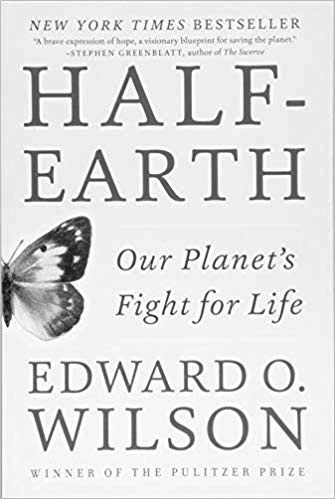Posted: April 15, 2019
Review of: Grandma Gatewood’s Walk: The Inspiring Story of the Woman Who Saved the Appalachian Trail by Ben Montgomery, Chicago Review Press Inc., 2014, ISBN 978-1-61374-718-6
Picture a teenager, lying on the lawn, transfixed by a column of ants. This teenager is now 89 years of age and a professor emeritus at Harvard. In 1990, Edward O. Wilson won the Pulitzer Prize for a 746-page book on ants.
Now he is observing the entire planet and has written a 358-page book subtitled, Our Planet's Fight for Life. He begins with the event of an asteroid, Chicxulub, hitting earth 65 million years ago, causing a volcanic winter and the disappearance of 70 percent of all species. That was the Fifth Extinction of life. Our human-initiated period could lead to the Sixth Extinction. In this, the Holocene epoch, our razor thin membrane, the biosphere, contains the biodiversity in which we live. Removal of one species can destabilize this entire ecosystem. He is not hopeful that this new epoch, called the Anthropocene, will last long.
Wilson uses his own words to describe the planet's changes. He takes you through time and species. Each species depends on the other species around it, and if one species is lost, those around it become extinct too. Humans are in this world because of the interdependency of species. That means we must protect enough of our planet to save native diversity. Native is the important word, as invasive species are a menace that will replace natural ecosystems and result in a greater loss of species.
And we live on a little-known planet. In 2015, the number of known animal and plant species was over two million, but it is possible that this accounts for only 20 percent of actual species. We often hear of new, large vertebrates being found, but we know little about the majority of invertebrates that really run the natural world. Although the book's focus is more on these smaller microinvertebrates, the large animals are not forgotten, and many that are already lost or endangered are described.
A bit of time is spent on this Anthropocene worldview where humans dominate the Earth, and who judge things useful only in terms of our species. Not only is this view negative, he says it is promoted by those who have had the least personal experience with the magnificence of biodiversity. Human control and technology can be positive. We can manufacture for high performance, less material, and a smaller amount of energy.
An especially interesting chapter is his location of the best places in the biosphere. Only two are in the US. One is the longleaf savanna in the South with its herbaceous and shrubby plant species. But very striking is the redwood forests of California. Surprisingly, this best place is not on the ground, but up in the crown of the trees. There are groves of trees growing in the soils that accumulate on immense tree branches, an inspiration to be aware of this ecosystem and to create more.
The earth cannot be divided into halves - areas with human ecological footprints and those without. Areas of surviving wild lands, and their accompanying "best places" are scattered around the planet.
This is a book to be read in episodes, for it is not a continuous story but separate tales of change that often need to be re-read to be understood. It is not one to read cover to cover on a rainy afternoon. Each chapter needs reflective thought and to be discussed with friends. It is a book to buy, or re-check out of the library. It is a book that may save us. For he equates the extinction rate because of our behavior with the Chicxulub-sized asteroid strike which led to that fifth mass extinction. We now face the Sixth Extinction and we only have a short time to decide if we can and will change.
Contact Information

James C. Finley Center for Private Forests
Address
416 Forest Resources BuildingUniversity Park, PA 16802
- Email PrivateForests@psu.edu
- Office 814-863-0401
- Fax 814-865-6275
James C. Finley Center for Private Forests
Address
416 Forest Resources BuildingUniversity Park, PA 16802
- Email PrivateForests@psu.edu
- Office 814-863-0401
- Fax 814-865-6275


